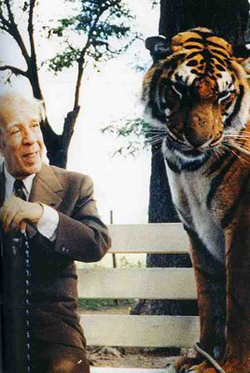Borges, Jorge Luis: My last tiger (Mi último tigre in English)
Mi último tigre (Spanish)En mi vida siempre hubo tigres. Tan entretejida está la lectura con los otros hábitos de mis días que verdaderamente no sé si mi primer tigre fue el tigre de un grabado o aquel, ya muerto, cuyo terco ir y venir por la jaula yo seguía como hechizado del otro lado de los barrotes de hierro. A mi padre le gustaban las enciclopedias; yo las juzgaba, estoy seguro, por las imágenes de tigres que me ofrecían. Recuerdo ahora los de Montaner y Simón (un blanco tigre siberiano y un tigre de Bengala) y otro, cuidadosamente dibujado a pluma y saltando, en el que había algo de río. A esos tigres visuales se agregaron los tigres hechos de palabras: la famosa hoguera de Blake (Tyger, tyger, burning bright) y la definición de Chesterton: Es un emblema de terrible elegancia. Cuando leí, de niño, los Jungle Books, no dejó de apenarme que Shere Kahn fuera el villano de la fábula, no el amigo del héroe. Querría recordar, y no puedo, un sinuoso tigre trazado por el pincel de un chino, que no había visto nunca un tigre, pero que sin duda había visto el arquetipo del tigre. Ese tigre platónico puede buscarse en el libro de Anita Berry, Art for Children. Se preguntará razonablemente ¿por qué tigres y no leopardos o jaguares? Sólo puedo contestar que las manchas me desagradan y no las rayas. Si yo escribiera leopardo en lugar de tigre, el lector intuiría inmediatamente que estoy mintiendo. A esos tigres de la vista y del verbo he agregado otro que me fue revelado por nuestro amigo Cuttini, en el curioso jardín zoológico cuyo nombre es Mundo Animal y que se abstiene de prisiones. Este último tigre es de carne y hueso. Con evidente y aterrada felicidad llegué a ese tigre, cuya lengua lamió mi cara, cuya garra indiferente o cariñosa se demoró en mi cabeza, y que, a diferencia de sus precursores, olía y pesaba. No diré que ese tigre que me asombró es más real que los otros, ya que una encina no es más real que las formas de un sueño, pero quiero agradecer aquí a nuestro amigo ese tigre de carne y hueso que percibieron mis sentidos esa mañana y cuya imagen vuelve como vuelven los tigres de los libros.
|
My last tiger (English)In my life I always had tigers. So interwoven is reading with the other habits of my days that really I do not know if my first tiger was the tiger in a print or the one, now dead, whose stubborn come and go in its cage I followed as if in a spell on the other side of the iron bars. My father enjoyed encyclopedias; I judged them, I am certain, by the images of tigers they offered me. I call to mind those of Montaner y Simón (a white Siberian tiger and a Bengal tiger) and another, carefully drawn in pen and leaping, in which there was something of rivers. To these visual tigers were joined tigers made of words: Blake's famous flame ("Tyger, tyger, burning bright") and Chesterton's definition, "an emblem of terrible elegance." When I read, as a child, the Jungle Books, they did not stop me grieving that Shere Khan was the villain of the piece, not the hero's friend. I would like to recall, and cannot, a sinuous tiger traced by the brush of a Chinese, who had never seen a tiger, but who had without doubt seen the archetype of the tiger. This Platonic tiger is to be found in a book by Anita Berry, Art for Children. One will wonder quite reasonably why tigers and not leopards or jaguars? I can only respond that spots displease me and not stripes. If I were to write leopard in place of tiger the reader would immediately intuit that I was lying. To these tigers of sight and word I have joined another which was revealed to me by our friend Cuttini, in the curious zoological garden whose name is Animal World and which abstains from prisons. This last tiger is of flesh and blood. With evident and terrified happiness I neared this tiger, whose tongue licked my face, whose indifferent or affectionate mitt lingered on my head, and which, unlike its precursors, possessed smell and weight. I will not say this tiger that amazed me is more real than the others, since an oak is not more real than the shapes of a dream, but I would like to thank here our friend, this tiger of flesh and blood my senses perceived that morning and whose image comes back as those tigers come back in books.
|
||||||||||||






